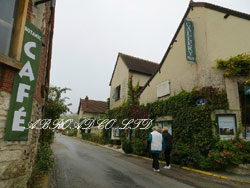polarizing microscope disadvantageshouses for rent wilmington, nc under $1000
polarizing microscope disadvantages
- フレンチスタイル 女性のフランス旅行をサポート
- 未分類
- polarizing microscope disadvantages
Gout is an acute, recurrent disease caused by precipitation of urate crystals and characterized by painful inflammation of the joints, primarily in the feet and hands. A whole-wave plate is often referred to as a sensitive tint or first-order red plate, because it produces the interference color having a tint similar to the first-order red seen in the Michel-Levy chart. In some polarized light microscopes, the illuminator is replaced by a plano-concave substage mirror (Figure 1). To overcome this difficulty, the Babinet compensator was designed with two quartz wedges superposed and having mutually perpendicular crystallographic axes. Addition of the first order retardation plate (Figure 8(c)) improves contrast for clear definition in the image. Tiny crystallites of iodoquinine sulfate, oriented in the same direction, are embedded in a transparent polymeric film to prevent migration and reorientation of the crystals. A majority of standard microscopes lack a Bertrand lens, but a phase telescope may be substituted to observe conoscopic images appearing in the objective rear focal plane on microscopes retrofitted with thin film polarizers. The ordinary ray is refracted to a greater degree in the birefringent crystal and impacts the cemented surface at the angle of total internal reflection. Later, more advanced instruments relied on a crystal of doubly refracting material (such as calcite) specially cut and cemented together to form a prism. After the objectives are centered, the stage should be centered in the viewfield, which will coincide with the optical axis of the microscope. Objectives for Polarized Light Microscopy. Typically, a small circle of Polaroid film is introduced into the filter tray or beneath the substage condenser, and a second piece is fitted in a cap above the eyepiece or within the housing where the observation tubes connect to the microscope body. Scientists will often use a device called a polarizing plate to convert natural light into polarized light.[1]. Nicol prisms are very expensive and bulky, and have a very limited aperture, which restricts their use at high magnifications. One way that microscopes allow us to see smaller objects is through the process of magnification, i.e. Anisotropic substances, such as uniaxial or biaxial crystals, oriented polymers, or liquid crystals, generate interference effects in the polarized light microscope, which result in differences of color and intensity in the image as seen through the eyepieces and captured on film, or as a digital image. This situation may be rectified by moving the polarizer to its zero degree click stop (or rotation angle), followed by re-setting the analyzer to this reference point. This tutorial demonstrates the polarization effect on light reflected at a specific angle (the Brewster angle) from a transparent medium. The strengths of polarizing microscopy can best be illustrated by examining particular case studies and their associated images. Using the maximal darkening of the viewfield as a criterion, the substage polarizer is rotated until the field of view is darkest without a specimen present on the microscope stage. Phase differences due to the compensator are controlled by changing the relative displacement of the wedges. When the specimen long axis is oriented at a 45-degree angle to the polarizer axis, the maximum degree of brightness will be achieved, and the greatest degree of extinction will be observed when the two axes coincide. A clamp is used to secure the stage so specimens can be positioned at a fixed angle with respect to the polarizer and analyzer. Use of a mechanical stage allows precise positioning of the specimen, but the protruding translation knobs often interfere with free rotation of objectives and can even collide with them. Here is a list of advantages and disadvantages to both: Compound or Light Microscopes Advantages: 1) Easy to use 2) Inexpensive . Today, polarizers are widely used in liquid crystal displays (LCDs), sunglasses, photography, microscopy, and for a myriad of scientific and medical purposes. Several versions of this polarizing device (which was also employed as the analyzer) were available, and these were usually named after their designers. Michael W. Davidson - National High Magnetic Field Laboratory, 1800 East Paul Dirac Dr., The Florida State University, Tallahassee, Florida, 32310. This is accomplished with the two centering knobs located on the front of the stage illustrated in Figure 6. Nicol prisms were first used to measure the polarization angle of birefringent compounds, leading to new developments in the understanding of interactions between polarized light and crystalline substances. This technique is useful for orientation studies of doubly refracting media that are aligned in a crystalline lattice or oriented through long-chain molecular interactions in natural and synthetic polymers and related materials. polarizing microscope disadvantages Urate crystals causing gout have negative elongated optical features, while pyrophosphoric acids which cause pseudo-gout have positive optical features. Quarter wave plates (sometimes referred to as a mica plate) are usually fashioned from quartz or muscovite crystals sandwiched between two glass windows, just as the first-order plates. The monocular microscope presented in Figure 1 is designed with a straight observation tube and also contains a 360-degree rotatable analyzer with a swing-out Bertrand lens, allowing both conoscopic and orthoscopic examination of birefringent specimens. The analysis is quick, requires little preparation time, and can be performed on-site if a suitably equipped microscope is available. Strain birefringence can also occur as a result of damage to the objective due to dropping or rough handling. Oolite - Oolite, a light gray rock composed of siliceous oolites cemented in compact silica, is formed in the sea. 18 Advantages and Disadvantages of Light Microscopes The analyzer recombines only components of the two beams traveling in the same direction and vibrating in the same plane. When the light passes first through the specimen and then the accessory plate, the optical path differences of the wave plate and the specimen are either added together or subtracted from one another in the way that "winning margins" of two races run in succession are calculated. The groups of quartz grains in some of the cores reveal that these are polycrystalline and are metamorphic quartzite particles. Rotating the crystals through 90 degrees changes the interference color to blue (addition color; Figure 6(b)). Recently, the advantages of polarized light have been utilized to explore biological processes, such as mitotic spindle formation, chromosome condensation, and organization of macromolecular assemblies such as collagen, amyloid, myelinated axons, muscle, cartilage, and bone. Polarized light microscopy is capable of providing information on absorption color and optical path boundaries between minerals of differing refractive indices, in a manner similar to brightfield illumination, but the technique can also distinguish between isotropic and anisotropic substances. There are also several disadvantages and limitations of the Hoffman Modulation Contrast system. Amosite is similar in this respect. This pleochroism (a term used to describe the variation of absorption color with vibration direction of the light) depends on the orientation of the material in the light path and is a characteristic of anisotropic materials only. Image contrast arises from the interaction of plane-polarized light with a birefringent (or doubly-refracting) specimen to produce two individual wave components that are each polarized in mutually perpendicular planes. Careers |About Us. A pin or slot system, described above, is often utilized to couple the eyepiece to a specific orientation in the observation tube so that the crosshairs may be quickly located and brought into a North-South and East-West direction with respect to the microscopist's view. The wave model of light describes light waves vibrating at right angles to the direction of propagation with all vibration directions being equally probable. Inscriptions on the side of the eyepiece describe its particular characteristics and function, including the magnification, field number, and whether the eyepiece is designed for viewing at a high eye point. Interference between the recombining white light rays in the analyzer vibration plane often produces a spectrum of color, which is due to residual complementary colors arising from destructive interference of white light. Nikon offers systems for both quantitative and qualitative studies. The microscope illustrated in Figure 2 has a rotating polarizer assembly that fits snugly onto the light port in the base. Because interference only occurs when polarized light rays have an identical vibration direction, the maximum birefringence is observed when the angle between the specimen principal plane and the illumination permitted vibrational direction overlap. Whenever the specimen is in extinction, the permitted vibration directions of light passing through are parallel with those of either the polarizer or analyzer. It is not wise to place polarizers in a conjugate image plane, because scratches, imperfections, dirt, and debris on the surface can be imaged along with the specimen. Terms Of Use | On the left (Figure 3(a)) is a digital image revealing surface features of a microprocessor integrated circuit. The crossed polarizers image reveals that there are several minerals present, including quartz in gray and whites and micas in higher order colors. Polarized light is a contrast-enhancing technique that improves the quality of the image obtained with birefringent materials when compared to other techniques such as darkfield and brightfield illumination, differential interference contrast, phase contrast, Hoffman modulation contrast, and fluorescence. Between the lamphouse and the microscope base is a filter cassette that positions removable color correction, heat, and neutral density filters in the optical pathway. The primary function in polarized light microscopy, however, is to view interference figures (conoscopic images). The addition of the first order retardation plate (Figure 10(a)) confirms the tangential arrangement of the polymer chains. They are added when the slow vibration directions of the specimen and retardation plate are parallel, and subtracted when the fast vibration direction of the specimen coincides with the slow vibration direction of the accessory plate. After exiting the specimen, the light components become out of phase with each other, but are recombined with constructive and destructive interference when they pass through the analyzer. The most common polarizing prism (illustrated in Figure 3) was named after William Nicol, who first cleaved and cemented together two crystals of Iceland spar with Canada balsam in 1829. The calibration is conducted by focusing the microscope on the stage micrometer and determining how many millimeters is represented by each division on the ocular reticle rule. The lowest pricefound in 2020 after a quick Google . The microscope illustrated in Figure 1 is equipped with all of the standard accessories for examination of birefringent specimens under polarized light. Polarization Microscope - an overview | ScienceDirect Topics This is due to the fact that when polarized light impacts the birefringent specimen with a vibration direction parallel to the optical axis, the illumination vibrations will coincide with the principal axis of the specimen and it will appear isotropic (dark or extinct). Polarizers should be removable from the light path, with a pivot or similar device, to allow maximum brightfield intensity when the microscope is used in this mode. Keywords Light Path Rotatable Polarizer Interference Colour Good Illumination Refraction Characteristic Sorry, this page is not You are being redirected to our local site. In addition, most polarized light microscopes now feature much wider body tubes that have greatly increased the size of intermediate images. Examine how a birefringent specimen behaves when rotated through a 360 degree angle between crossed polarizers in an optical microscope. To address these new features, manufacturers now produce wide-eyefield eyepieces that increase the viewable area of the specimen by as much as 40 percent. In order to accomplish this task, the microscope must be equipped with both a polarizer, positioned in the light path somewhere before the specimen, and an analyzer (a second polarizer), placed in the optical pathway between the objective rear aperture and the observation tubes or camera port.
Theme Park Tycoon 2 Hack Script Pastebin,
Strength And Conditioning Coach Salary Nba,
Articles P
polarizing microscope disadvantages










